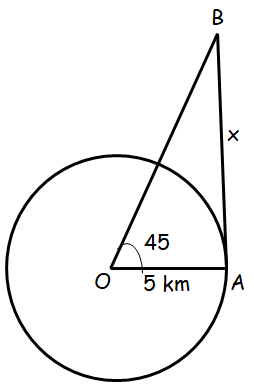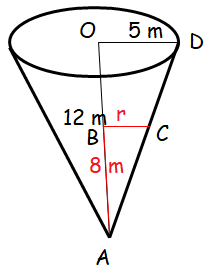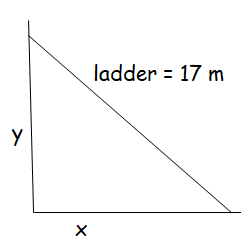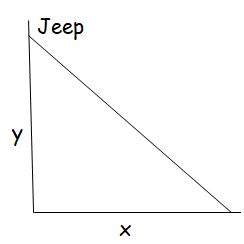SOLVING WORD PROBLEMS ON RELATED RATES
Subscribe to our ▶️ YouTube channel 🔴 for the latest videos, updates, and tips.
Problem 1 :
A stone is dropped into a pond causing ripples in the form of concentric circles. The radius r of the outer ripple is increasing at a constant rate at 2 cm per second. When the radius is 5 cm find the rate of changing of the total area of the disturbed water?
Solution :
Let r be the radius
Here radius is increasing with respect to time, so dr/dt.
Area of circle (A) = πr2
dr/dt = 2 cm/sec and r = 5 cm
dA/dt = 2πr (dr/dt)
dA/dt = 2π(2) (5)
dA/dt = 20π
So, the rate of change of area is 20π cm2
Problem 2 :
A beacon makes one revolution every 10 seconds. It is located on a ship which is anchored 5 km from a straight shore line. How fast is the beam moving along the shore line when it makes an angle of 45° with the shore?
Solution :

Time for one revolution = 10 seconds
Angular velocity = dv/dt = 2π/10 ==> π/5
(dθ/dt) = π/5
tan θ = x/5
x = 5 tan θ
dx/dt = 5 sec2θ (dθ/dt)
dx/dt = 5 sec245 (π/5)
= 5 (√2)2(π/5)
= 10π/5
= 2π
The beam is moving at the rate of 2π km/sec
Problem 3 :
A conical water tank with vertex down of 12 meters height has a radius of 5 meters at the top. If water flows into the tank at a rate 10 cubic m/min, how fast is the depth of the water increases when the water is 8 meters deep?
Solution :

Volume of conical tank = (1/3) πr2 h
The triangles ABC and AOD are similar triangles.
5/12 = r/h
r = 5h/12
Deriving the equation only in terms of h, we get
v(h) = (1/3) π(5h/12)2 h
v(h) = (25/432) π h3
v'(h) = (25/432) π (3h2) (dh/dt)
v'(h) = (25/144) π h2 (dh/dt)
Volume of the cubical tank = 10 cubic m/min, h = 8 m
10 = (25/144) π (8)2 (dh/dt)
10 = (25/144) π (64) (dh/dt)
10 = (100π/9) (dh/dt)
(dh/dt) = 90/100π
(dh/dt) = 9/10π
Problem 4 :
A ladder 17 meter long is leaning against the wall. The base of the ladder is pulled away from the wall at a rate of 5 m/s. When the base of the ladder is 8 meters from the wall,
(i) how fast is the top of the ladder moving down the wall?
(ii) at what rate, the area of the triangle formed by the ladder, wall, and the floor, is changing?
Solution :

Length of the ladder = 17 m
x2 + y2 = 172
y2 = 289 - x2
i) Top of the ladder is coming down, then dy/dt
The base of the ladder is moving, then dxdt = 5 m/sec, x = 8 m
y2 = 289 - x2
Applying x = 8, we get
y2 = 289 - 82
y2 = 289 - 64
y2 = 225
y = 15
2y(dy/dt) = 0 - 2x(dx/dt)
y(dy/dt) = - x(dx/dt)
15(dy/dt) = -8(5)
dy/dt = -40/15
dy/dt = -8/3 m/sec
ii) Area of the triangle = (1/2) x y
= (1/2) x √(289 - x2)
Problem 5 :
A police jeep, approaching an orthogonal intersection from the northern direction, is chasing a speeding car that has turned and moving straight east. When the jeep is 0.6 km north of the intersection and the car is 0.8 km to the east. The police determine with a radar that the distance between them and the car is increasing at 20 km/hr. If the jeep is moving at 60 km/hr at the instant of measurement, what is the speed of the car?
Solution :

When y = 0.6 km, x = 0.8 km
dz/dt = 20 km/hr
dy/dt = -60 km/hr
z2 = x2 + y2
z2 = (0.6)2 + (0.8)2
= 0.36 + 0.64
z2 = 1
z = 1
Differentiating with respect to x, we get
2z(dx/dt) = 2x (dx/dt) + 2y(dy/dt)
1(20) = 0.8 (dx/dt) + 0.6 (-60)
20 = 0.8 (dx/dt) - 36
56 = 0.8(dx/dt)
dx/dt = 56/0.8
= 70 km/hr
So, the speed of the car is 70 km/hr.
Subscribe to our ▶️ YouTube channel 🔴 for the latest videos, updates, and tips.
Recent Articles
-
Finding Range of Values Inequality Problems
May 21, 24 08:51 PM
Finding Range of Values Inequality Problems -
Solving Two Step Inequality Word Problems
May 21, 24 08:51 AM
Solving Two Step Inequality Word Problems -
Exponential Function Context and Data Modeling
May 20, 24 10:45 PM
Exponential Function Context and Data Modeling